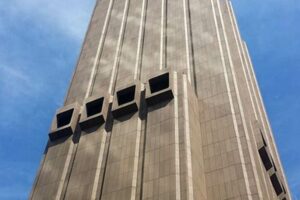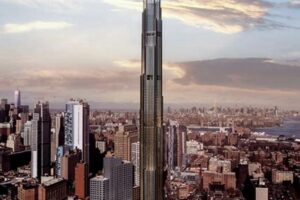The Skyscraper Museum in New York City is a museum dedicated to the history and architecture of skyscrapers. It is located in the Battery Park City neighborhood of Manhattan, and it houses a collection of over 2,000 artifacts, including models, drawings, and photographs. The museum also has a library and research center, and it offers a variety of educational programs and exhibitions.
The Skyscraper Museum was founded in 1997 by Carol Willis, an architectural historian and curator. Willis was inspired to create the museum after she curated an exhibition on skyscrapers at the Museum of Modern Art in New York City. The museum’s mission is to “celebrate the skyscraper as a symbol of human achievement and ingenuity.” The museum’s collection includes artifacts from some of the world’s most famous skyscrapers, including the Empire State Building, the Chrysler Building, and the World Trade Center.
The Skyscraper Museum is a valuable resource for anyone interested in the history and architecture of skyscrapers. The museum’s collection, library, and educational programs provide a unique opportunity to learn about these iconic structures. The museum also offers a variety of public programs, including lectures, tours, and workshops.
1. Collection
The collection of over 2,000 artifacts at the Skyscraper Museum in NYC serves as the foundation of the museum’s mission to preserve and celebrate the history and architecture of skyscrapers. These artifacts, which include models, drawings, and photographs, provide a tangible and immersive experience for visitors, allowing them to trace the evolution of skyscraper design and construction.
The collection is particularly significant because it offers a comprehensive overview of skyscraper development from its early origins to the present day. The models, drawings, and photographs capture the architectural innovations, engineering challenges, and cultural influences that have shaped skyscrapers over the centuries. For example, the museum’s collection includes models of the Home Insurance Building (1885), one of the first skyscrapers in the world, and the Burj Khalifa (2010), the tallest building in the world.
The practical significance of this collection lies in its ability to educate and inspire architects, historians, and the general public. By providing access to these artifacts, the Skyscraper Museum fosters a deeper understanding and appreciation of the architectural and historical significance of skyscrapers. It also serves as a valuable resource for researchers and scholars, who can use the collection to conduct in-depth studies on skyscraper design and construction.
In conclusion, the collection of over 2,000 artifacts at the Skyscraper Museum in NYC is an invaluable resource that provides a comprehensive overview of skyscraper development. These artifacts offer a unique opportunity to learn about the architectural innovations, engineering challenges, and cultural influences that have shaped skyscrapers over the centuries, inspiring future generations to continue pushing the boundaries of architectural design.
2. Exhibitions
The Skyscraper Museum in NYC presents rotating exhibitions that delve into specific themes and aspects of skyscraper design and construction. These exhibitions showcase diverse perspectives, highlighting the architectural, engineering, and cultural significance of skyscrapers. By presenting a range of topics, the museum provides a comprehensive exploration of these iconic structures.
One notable aspect of the museum’s exhibitions is their focus on the evolution of skyscraper design. Visitors can trace the historical progression of skyscraper architecture, from its early beginnings to contemporary innovations. The exhibitions explore how skyscrapers have adapted to changing technologies, societal needs, and aesthetic preferences. For instance, past exhibitions have examined the impact of Art Deco on skyscraper design in the early 20th century and the rise of sustainable skyscraper design in recent years.
Furthermore, the Skyscraper Museum’s exhibitions often highlight the work of renowned architects and engineers who have shaped the skyline of New York City and beyond. By showcasing the contributions of these individuals, the museum recognizes the artistry and ingenuity involved in skyscraper design and construction. Visitors gain insights into the creative process and the challenges faced by architects and engineers in pushing the boundaries of architectural design.
In conclusion, the rotating exhibitions at the Skyscraper Museum in NYC serve as a valuable platform for exploring the multifaceted world of skyscraper architecture. Through diverse themes and perspectives, these exhibitions provide a comprehensive understanding of the design, construction, and cultural impact of skyscrapers. They offer a unique opportunity for visitors to engage with the history and ongoing evolution of these architectural marvels.
3. Research
The Skyscraper Museum in New York City houses a specialized research center and library that cater to the needs of scholars, enthusiasts, and researchers interested in the field of skyscraper architecture. This valuable resource supports the museum’s mission of preserving and disseminating knowledge about skyscrapers.
- Access to Rare and Specialized Materials: The research center provides access to a vast collection of books, periodicals, archival documents, and other materials related to skyscraper design and construction. These resources are often rare or difficult to find elsewhere, making the museum a unique destination for researchers.
- Collaboration and Networking Opportunities: The research center fosters collaboration and networking among scholars and enthusiasts. It hosts regular events, lectures, and workshops that bring together experts in the field to share their knowledge and research findings.
- Support for Scholarly Research: The research center provides support for scholarly research projects, offering access to its collection and expertise to researchers. This support enables scholars to conduct in-depth studies on skyscraper architecture, contributing to the advancement of knowledge in the field.
- Educational Value: The research center serves as an educational resource for students, architects, and the general public. It provides opportunities for learning about skyscraper history, design principles, and construction techniques.
In conclusion, the research center and library at the Skyscraper Museum in New York City play a crucial role in supporting research, fostering collaboration, and advancing the understanding of skyscraper architecture. They are invaluable resources for scholars, enthusiasts, and anyone interested in the history and evolution of these architectural marvels.
4. Education
The Skyscraper Museum in New York City recognizes the importance of education in fostering an appreciation and understanding of skyscraper architecture. Through a range of educational programs, lectures, and workshops, the museum aims to engage audiences of all ages and backgrounds.
These educational initiatives serve several key purposes. Firstly, they provide a platform for sharing knowledge and expertise on skyscraper design, construction, and history. Lectures by renowned architects, engineers, and historians offer unique insights into the creative process and the challenges involved in skyscraper development. Workshops, on the other hand, provide hands-on experiences, allowing participants to engage with skyscraper design principles and techniques.
Furthermore, the museum’s educational programs play a crucial role in inspiring future generations of architects and engineers. By introducing young minds to the world of skyscrapers, the museum fosters an interest in STEM fields and encourages the pursuit of careers in architecture and engineering. Through interactive programs and design challenges, students develop their creativity, problem-solving skills, and an appreciation for the built environment.
In conclusion, the “Education: Offers educational programs, lectures, and workshops on skyscraper architecture” component of the Skyscraper Museum in New York City serves as a vital bridge between the museum’s collection and the community. These educational initiatives not only enhance the visitor experience but also contribute to the broader goal of promoting knowledge, inspiring future generations, and fostering a deeper understanding of the architectural marvels that shape our cities.
5. Preservation
The Skyscraper Museum in New York City serves as a staunch advocate for the preservation of historic skyscrapers. This commitment stems from the recognition that these structures embody significant architectural, historical, and cultural value. Preserving historic skyscrapers ensures that future generations can continue to appreciate and learn from these architectural marvels.
The museum’s advocacy efforts take various forms. One key initiative is the “Endangered Skyscraper List,” which identifies skyscrapers that are at risk of demolition or significant alteration. By raising awareness about these threatened structures, the museum mobilizes public support and encourages decision-makers to consider preservation options.
Furthermore, the museum actively collaborates with preservation organizations and government agencies to develop and implement preservation policies. Their expertise in skyscraper architecture and history enables them to provide valuable insights into the evaluation and protection of these iconic buildings. Through these collaborative efforts, the museum contributes to the establishment of legal frameworks and incentives that support the preservation of historic skyscrapers.
The practical significance of preserving historic skyscrapers extends beyond their aesthetic and historical value. These structures often contribute to the economic vitality of their surroundings, attracting tourists and businesses. Moreover, they serve as reminders of the architectural advancements and cultural heritage of a city. By preserving historic skyscrapers, we not only safeguard our built environment but also maintain a tangible connection to our past.
In conclusion, the Skyscraper Museum in New York City plays a crucial role in advocating for the preservation of historic skyscrapers. Their efforts raise awareness, inform decision-making, and contribute to the development of preservation policies. Recognizing the architectural, historical, and cultural significance of historic skyscrapers is essential for ensuring that future generations can continue to appreciate and learn from these architectural marvels.
6. Context
The Skyscraper Museum in New York City recognizes that skyscrapers are not merely architectural achievements but also have a profound impact on the social, cultural, and economic fabric of cities. This component of the museum’s mission explores the multifaceted ways in which skyscrapers shape and are shaped by their surroundings.
One key aspect of this exploration is examining how skyscrapers influence the social interactions and dynamics within a city. For example, the museum delves into how skyscrapers can foster a sense of community and belonging among residents, while also potentially contributing to social stratification and segregation. The museum also investigates the impact of skyscrapers on urban planning and development, considering how they shape transportation patterns, public spaces, and the distribution of resources.
Furthermore, the Skyscraper Museum analyzes the cultural significance of skyscrapers as symbols and landmarks. These structures often embody the aspirations and values of a city or era, becoming iconic representations of urban identity. The museum explores how skyscrapers reflect cultural trends, artistic movements, and technological advancements, providing insights into the evolving nature of society.
The economic impact of skyscrapers is another crucial aspect that the museum examines. Skyscrapers have played a significant role in driving economic growth and development, providing spaces for businesses, commerce, and innovation. However, the museum also considers the potential drawbacks, such as the displacement of small businesses and the concentration of wealth in certain areas.
Understanding the context of skyscrapers is essential for a comprehensive appreciation of their architectural and historical significance. By exploring the social, cultural, and economic impact of skyscrapers, the Skyscraper Museum in New York City provides valuable insights into these architectural marvels and their role in shaping urban environments.
7. Innovation
The Skyscraper Museum in New York City recognizes that innovation is an integral part of skyscraper design and technology. This component of the museum’s mission highlights the ongoing advancements that push the boundaries of architectural engineering and redefine the skylines of cities worldwide.
The museum showcases innovative concepts and cutting-edge technologies that are transforming skyscraper design. Visitors can explore interactive exhibits that demonstrate sustainable building materials, energy-efficient systems, and advanced construction techniques. By presenting these innovations, the museum fosters a deeper understanding of the challenges and opportunities in contemporary skyscraper development.
Understanding the latest advancements in skyscraper design and technology is crucial for several reasons. Firstly, it allows architects and engineers to stay abreast of the latest trends and incorporate innovative solutions into their designs. Secondly, it inspires future generations to pursue careers in STEM fields, particularly in architecture and engineering. Finally, it raises public awareness about the importance of innovation in creating sustainable and resilient urban environments.
In conclusion, the “Innovation: Showcases the latest advancements in skyscraper design and technology” component of the Skyscraper Museum in New York City plays a vital role in promoting innovation and inspiring future generations of architects and engineers. By showcasing cutting-edge technologies and design concepts, the museum contributes to the advancement of skyscraper architecture and the creation of sustainable and resilient cities.
FAQs about Skyscraper Museum in NYC
The Skyscraper Museum in New York City is a renowned institution dedicated to preserving and celebrating the history and architecture of skyscrapers. In this FAQ section, we address common concerns and misconceptions about the museum and its significance:
Question 1: What is the main focus of the Skyscraper Museum?
The Skyscraper Museum’s primary focus is to collect, preserve, and exhibit artifacts, documents, and artworks related to the history and architecture of skyscrapers. It showcases the architectural innovations, engineering challenges, and cultural impact of skyscrapers worldwide.
Question 2: What types of exhibits can visitors expect to see at the museum?
The museum presents a diverse range of exhibits, including models, drawings, photographs, and interactive displays. These exhibits explore various aspects of skyscraper design, construction, and their impact on urban landscapes.
Question 3: Is the museum suitable for visitors of all ages?
Yes, the Skyscraper Museum offers engaging and educational experiences for visitors of all ages. Interactive exhibits, guided tours, and educational programs are designed to appeal to both children and adults.
Question 4: How can I learn more about skyscraper architecture through the museum?
In addition to exhibits, the museum offers a library and research center with an extensive collection of books, periodicals, and archival materials. Visitors can access these resources to conduct research or deepen their understanding of skyscraper architecture.
Question 5: Does the museum host any special events or programs?
Yes, the Skyscraper Museum organizes various events throughout the year, including lectures, workshops, film screenings, and panel discussions. These events provide opportunities for visitors to engage with experts in the field and learn about current trends and advancements in skyscraper design.
Question 6: How can I support the Skyscraper Museum?
There are several ways to support the Skyscraper Museum, including becoming a member, donating funds, or volunteering time. By supporting the museum, individuals contribute to preserving and promoting the legacy of skyscrapers as architectural marvels.
In conclusion, the Skyscraper Museum in New York City serves as a valuable resource for anyone interested in the history, architecture, and cultural significance of skyscrapers. Its exhibits, educational programs, and research facilities provide a comprehensive understanding of these iconic structures.
To learn more about the Skyscraper Museum and plan your visit, please visit their official website at [Insert Website URL].
Tips from the Skyscraper Museum in NYC
The Skyscraper Museum in New York City is a treasure trove of knowledge and inspiration for anyone interested in the history, architecture, and cultural impact of skyscrapers. Here are a few tips from the museum to enhance your appreciation of these architectural marvels:
Tip 1: Understand the Context
Skyscrapers are not just isolated structures; they are integral parts of the urban fabric. Take time to explore the surrounding neighborhood and learn about the historical, social, and economic factors that influenced the skyscraper’s design and development.
Tip 2: Observe the Details
Skyscrapers are often adorned with intricate details and ornamentation. Pay attention to the building’s facade, lobby, and common areas to discover hidden gems and appreciate the craftsmanship involved.
Tip 3: Consider the Engineering
Skyscrapers are feats of engineering ingenuity. Learn about the innovative structural systems, materials, and construction techniques that make these towering structures possible.
Tip 4: Appreciate the Aesthetics
Skyscrapers are not just functional structures; they are also works of art. Admire the architectural style, form, and proportions of the building, and consider how it contributes to the overall cityscape.
Tip 5: Explore the Interiors
Don’t just admire skyscrapers from afar; take the opportunity to explore their interiors. Visit observatories, public spaces, and tenant areas to experience the building’s ambiance and design from within.
Tip 6: Learn from the Past
Skyscrapers have a rich history that can inform our understanding of architecture and urban development. Visit the Skyscraper Museum to delve into the evolution of skyscraper design and its impact on cities worldwide.
Tip 7: Engage with Experts
Attend lectures, workshops, and guided tours offered by the Skyscraper Museum. These programs provide valuable insights from experts in the field of skyscraper architecture and design.
Tip 8: Support Preservation
Skyscrapers are cultural and architectural landmarks that deserve to be preserved for future generations. Support organizations like the Skyscraper Museum that advocate for the preservation and restoration of these iconic structures.
By following these tips, you can deepen your appreciation for skyscrapers and gain a greater understanding of their architectural, historical, and cultural significance.
Conclusion
The Skyscraper Museum in New York City stands as a testament to the architectural ingenuity and cultural significance of skyscrapers. Through its collection, exhibitions, educational programs, and advocacy efforts, the museum provides a comprehensive exploration of these iconic structures.
The museum’s commitment to preserving and celebrating skyscrapers highlights their impact on urban development, engineering advancements, and the shaping of city skylines. By fostering an understanding of skyscraper architecture, the museum inspires future generations of architects, engineers, and enthusiasts to continue pushing the boundaries of design and innovation.
In conclusion, the Skyscraper Museum in New York City serves as a valuable resource for anyone interested in the history, architecture, and cultural impact of skyscrapers. Its mission to preserve and promote these architectural marvels ensures that their legacy will continue to inspire and captivate for generations to come.







